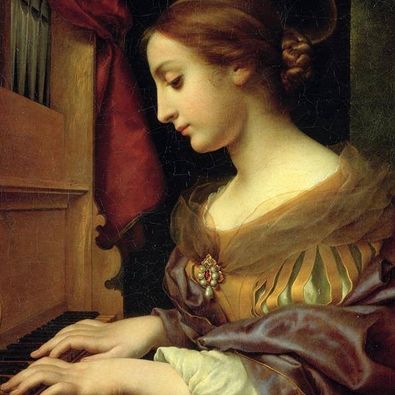Saint Cecilia, Patron Saint of Cathedral and the Omaha Archdiocese
Her feast is November 22.
Learn More

Her Life
Saint Cecilia probably lived in the second or third century, and tradition says she died about 177 AD. Although details of her life may be unknown to us, Saint Cecilia was one of the most revered early virgin martyrs of Rome, as evidenced by her name appearing in the Roman Canon of the Mass (Eucharistic Prayer 1). She is one of the seven women commemorated by name in the Roman Canon. There is evidence of a church named in her honor dating to the late fourth century. A feast day in honor of Saint Cecilia was celebrated as early as 545.
Cecilia was born in a wealthy Roman family and was a Christian by birth. Her family gave her in marriage to Valerius, a pagan nobleman. Cecilia promised to remain a virgin, and she was successful in persuading Valerius to respect her virginity on their wedding night. Later, Valerius was converted to Catholicism along with his brother, Tiburtius.
These two brothers dedicated themselves to burying the Christian martyrs, which was illegal. They were arrested and sentenced to death for refusing to renounce their religion.
Cecilia continued the work of converting people to the Christian faith and of burying the Christian dead, even though it was against the law. Hundreds were baptized through her witness and strength of faith. She planned to have her home preserved as a church after her death. Her refusal to worship false gods and her burying of the dead lead to her arrest.
Saint Cecilia was brought to trial and sentenced to death. It took several days for her to die, and it is said that she converted many people who came to care for her as she was dying. Saint Cecilia died lying on her right side with her hands crossed in prayer. The position of her fingers—three extended on her right hand, and one on the left—were her final silent profession of faith in the Holy Trinity, Three Persons in one God. Saint Cecilia was buried in the Catacomb of Saint Callistus.
In the Middle Ages, Saint Cecilia became a very popular saint. She is remembered today as the patron of musicians, composers, instrument makers, and poets. There is a story that Saint Cecilia was said to have heard heavenly music inside her heart when she was forced to marry the pagan Valerian. During her wedding, Cecilia sat and sang to God in her heart. Thus, she was declared to be the patron of musicians. Musical compositions, poems, art, and festivals have grown out of this story.
In the Cathedral
Saint Cecilia is the heart and soul of this great church, the only cathedral in the United States dedicated to the patron saint of music and musicians. She is also honored as the patron of the Omaha Archdiocese.
Her exterior statue in pure white Carrara marble crowns the west facade, high above the great bronze doors. On Saint Cecilia's feast day, November 22, 2000, a statue of Saint Cecilia and three other saints were blessed by Archbishop Elden Curtiss and placed in niches on the church's facade. The alcoves had been waiting eighty-eight years. All are originals and were carved in Italy of renowned Carrara marble. Saint Cecilia, at eight feet and the tallest, occupies a nice eighty-five feet above ground in the center of the west facade, the main entrance to the Cathedral. Her hair is unbound, maidenly, and her robe is loose and modest. The upturned face is given a luminescence by the white marble. In her arms, the patron saint of music holds a portative organetto, which could be played for its own sweet sound or to accompany singing. One is reminded of Psalm 150: "Praise the Lord with everything that has breath!" The statue of Saint Cecilia was an anonymous gift in memory of the Archbishop's mother, Mary Curtiss.
The magnificent rose window portrays Cecilia as a young woman, serene and confident, the center of a symphony of praiseful music. At the center of the modified quatrefoil is the figure of the virgin martyr, crowned with traditional red and white roses. She holds an open psalter inscribed: "Let every spirit praise the Lord" (Psalm 150). Children of the earthly choir and angels of the heavenly choir surround Saint Cecilia. At her feet is the text from the first antiphon at the Office of Matins on her feast: "At the sound of musical instruments, the virgin Cecilia sang to God in her heart."
On the side walls, high in the entablature, are gilded antiphons from the Divine Office for Saint Cecilia: Alleluja--Alleluja, Dum aurora finem daret, Caecilia exlamavit dicens: Eja, milites Christi, abjicite opera tenabrarum et induimini arma lucis.
(Alleluia--Alleluia, as dawn was breaking into day, Cecilia cried out saying: Courage, soldiers of Christ, cast away the deeds of darkness and put ye on the armor of light.) (north wall)
Cantanibus organis Caecilia Domino decantabat dicens: Fiat cor meum Immaculatum, ut non confundar. Alleluja--Alleluja.
(While the musical instruments were playing, Cecilia sang unto the Lord saying: Let my heart be undefiled that I be not ashamed. Alleluia--Alleluia.) (south wall)
Completing this radiant halo of Saint Cecilia is the prayer above the altar: Sancta Caecilia, Virgo Martyr, ora pro nobis. (Saint Cecilia, virgin and martyr, pray for us.)
In Music and Art
Stefano Maderno is best known for his marble statue of St Cecilia (1600) at the high altar of Santa Cecilia in Trastevere, Rome. This work, which established Maderno's reputation, was commissioned by Cardinal Paolo Emilio Sfondrato, the titular cardinal of the church, who had undertaken extensive excavations of the building in the hope of finding the remains of St Cecilia. The discovery of her supposed entire and uncorrupt body on 20 October 1599 under the main altar was a momentous occasion in Rome, especially within the context of the Counter-Reformation. Sfondrato commissioned Maderno to reconstruct the altar and to carve, as its centrepiece, a statue of the recumbent saint.
Maderno depicted St Cecilia precisely the way Antonio Bosio described her at the moment of discovery: uncorrupt, lying on her side, clad in a dress, with her veiled head turned towards the ground. This gave rise to the assumption, fostered by Baglione and other writers, that the statue was based on direct study of the corpse. It is now generally recognized, however, that the statue is an ingenious invention of Maderno, indebted to ancient sculptures, and based on Bosio's description of St Cecilia's body.
The St Cecilia is a mature expression of Maderno's talent as a sculptor. The statue is a work of classical simplicity and directness in presentation, which presages later developments in Baroque sculpture. It is designed to be seen from a single viewpoint and characterized by an emotive intensity, and a naturalism tempered by idealization that is also evident in contemporary works by Guido Reni in painting and Camillo Mariani in sculpture. The St Cecilia served as the model for a series of Roman Baroque statues of recumbent saints, including the St Martina (1635; Santi Luca e Martina) by Niccolò Menghini, Gian Lorenzo Bernini's Blessed Ludovica Albertoni (1671-74; San Francesco a Ripa) and the St Sebastian (1671-72; San Sebastiano fuori le Mura) by Giuseppe Giorgetti.
A few other examples of the many artistic works about Saint Cecilia:
+ Chaucer commemorates Saint Cecilia in his “Second Nun’s Tale.”
+ John Dryden’s poem “A Song for Saint Cecilia’s Day” was set to music by Handel in his “Ode for Saint Cecilia’s Day.”
+ Charles Gounod composed the Saint Cecilia Mass.
+ Benjamin Britten composed the “Hymn to Saint Cecilia.”
Saint Cecilia reminds us of the ways that our music and art can lead us to praise God.
